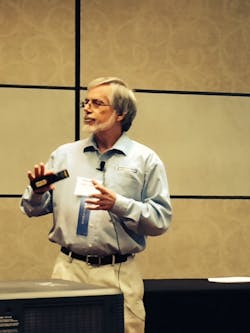There is good news for manufacturing in America—it’s coming back. That’s apparent in South Carolina where manufacturers have committed to invest $11.7 billion to create 37,000 new manufacturing jobs.
The problem, however, is filling those jobs. That’s why Randy Crutfield, site hiring manager at Michelin North America’s Lexington, S.C. factory, has developed a workforce development strategy for ensuring a steady stream of trained automation employees.
Michelin’s Lexington tire factory is competing locally with Boeing, Kimberly-Clark, Bridgestone, Continental Tire, and soon Mercedes, among other manufacturers, so there is a lot of pressure to acquire technical talent. Plus, baby boomers at the plant are retiring. These dynamics demanded a change, says Crutfield, who outlined Michelin’s “brute force” approach to finding qualified applicants during a session at The Automation Conference hosted by Automation World this week in Chicago.
Rather than wait for people to apply for automation jobs, “We go out and look for people with a two-year degree or military experience. We do aptitude testing, and we end up hiring eight out of every 100 qualified applicants,” Crutfield says.
Michelin reinforces its strategy by partnering with local high schools and technical colleges—forming a steering committee-- to direct the right individuals toward a technical career path, offering tuition scholarships and full-time employment (with an entry-level salary of $50,000) upon completion of the 2-year technical scholar program in addition to passing the Michelin aptitude test.
Together, the team identifies qualified candidates, some still in high school, and present a unique recruitment program beginning with branding—to get the millennials interested in manufacturing.
“The objective of the branding team is to put a face on the automation technician,” says Crutfield, “as well as to provide an accurate portrayal of the manufacturing industry, showing that it is a good place to work.”
As part of that branding process, Crutfield shows his digital native job candidates that the manufacturing environment is sophisticated and the use of mobile and simulation technology are a big part of the role.
Once accepted into the program, a student must keep satisfactory grades and pass the Michelin aptitude test. They are also required to work part-time at the tire factory. The total investment per student is about $25,000, Crutfield says. But well worth it if a student remains on as a Michelin employee.
In addition, the company will provide tuition reimbursement if the employee decides to move on to a four-year engineering program.
For a successful workforce development program, Crutfield says manufacturers should not only partner with local tech schools and community colleges to create a cross-functional leadership team, but also offer apprentice programs, engage with students, and be willing to support the program with the necessary resources.
About the Author
Stephanie Neil
Editor-in-Chief, OEM Magazine

Leaders relevant to this article:
